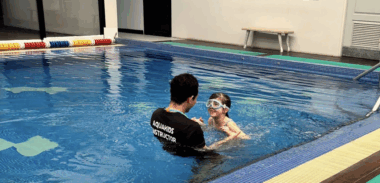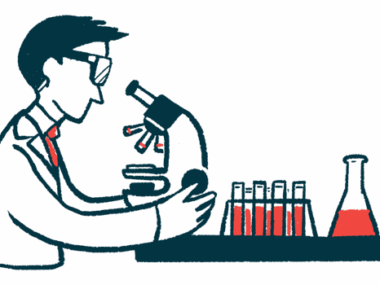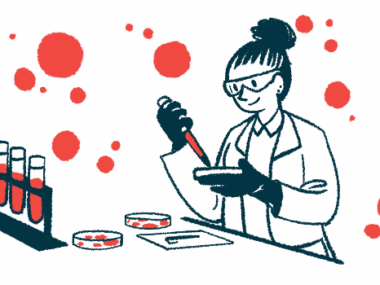Our little ‘mermaid-in-training’ ventures back into the water
Spending time in a pool has been a big part of teaching Rylae-Ann to walk
Written by |

When you’re the parent of a child with a rare disease like aromatic l-amino acid decarboxylase (AADC) deficiency, you quickly learn that progress doesn’t come in straight lines. It zigzags, loops, and sometimes takes detours through unexpected places. For our daughter, Rylae-Ann, one of the most important places on her journey has been the swimming pool.
AADC deficiency is one of those sneaky villains, affecting about 1 in a million children worldwide, that robs the body of dopamine and serotonin, the neurotransmitters needed for muscle control and mood regulation. It leaves kids with such low muscle tone that even the simplest movements, like lifting their head or waving hello, can feel like climbing Mount Everest. Without treatment, many children remain bedridden, unable to sit, stand, or even smile on command.
But Rylae-Ann is our pint-sized warrior princess. At just 18 months, she became one of the youngest children to undergo groundbreaking gene therapy as part of a clinical trial in Taiwan. This one-time procedure involves injecting a healthy gene into her brain to kickstart the missing neurotransmitters. It was terrifying, exhilarating, and life-changing all at once. Post-therapy, she’s progressed by leaps and bounds — from her first intentional smile to crawling, standing, and now running with joy.
And yet, as in any epic quest, there are still dragons to slay. Strength and coordination remain her biggest hurdles. Her muscles tire quickly and her fine motor skills are still a work in progress. But water has been the tool that helps change all that.
The magic of weightlessness
Even before gene therapy, my wife, Judy, and I were determined not to let AADC deficiency win. We bundled up our tiny bundle of joy and introduced her to the pool when she was just a few months old. In the water, gravity seems to take a vacation; the near-weightlessness she experienced was like a superpower. She could “stand” on her own for the first time, feel her legs kick without the pull of the Earth, and experience movement in a way she couldn’t on land. It was pure magic.
Those early dips weren’t just playtime. They were therapy in disguise. We’d float her gently, watching her eyes light up as if to say, “Hey, this freedom thing? I like it!” The pool became our secret weapon after gene therapy, playing a massive role in teaching her to walk.
Water resistance built strength without strain, and the fun factor kept her motivated. Every splash session was a mini-milestone party. Judy encouraged her first wobbly steps across the shallow end, me cheering with pool noodles and silly songs. “You’re a mermaid-in-training!” I’d yell, and her laughter would echo off the walls.
The swim class experiment

Rylae-Ann rejoins a private swimming class and demonstrates her kicking and breathing skills. (Photo by Richard E. Poulin III)
We enrolled her in group swim classes, dreaming of her paddling alongside peers. But as with school, group settings had their pitfalls. Rylae-Ann’s progress is steady, but slower than her classmates’, which made it challenging for her instructors to give her the attention she needed. The teachers meant well, but juggling a dozen splashing kiddos is like herding cats in a hurricane.
Frustrated, but undeterred, we switched to a one-on-one swim coach. It was a game changer. With undivided attention, she blossomed, mastering floats, kicks, and even basic strokes. It was entertaining to watch her “coach” us right back, splashing water in our faces with mischievous glee.
Over the last six months, swimming has taken a back seat as we’ve dealt with some big transitions — pulling Rylae-Ann from traditional school, starting homeschooling, building new routines, and weaving therapies into her day. Life threw curveballs and the pool had to wait.
Dipping back in
But Judy, my rock and master planner, knew we couldn’t stay away from the water. She wove physical therapy and swimming into Rylae-Ann’s school schedule. “No more excuses,” she said with that determined sparkle in her eye.
Our first day back at the pool last week was priceless. As her toes touched the cool water, she squealed with delight, arms flailing like an excited octopus, while Judy and I beamed like proud penguins. Her kicks were stronger, her balance steadier. The water’s gentle resistance was rebuilding her core strength and coordination, all while teaching her an essential life skill.
That brief hiatus was a wake-up call. Water isn’t just fun for Rylae-Ann; it’s a lifeline. It levels the playing field, turning “impossible” into “I’ve got this!” For other parents navigating rare diseases or developmental delays, I say: Dive in! Start with bath time adventures, graduate to kiddie pools, and explore adaptive swim programs.
It’s entertaining but profoundly inspirational. Watching your child defy odds in the waves reignites hope, strengthens family bonds, and reminds us all that progress often comes in ripples, not tsunamis.
For our family, the water is one of those rare places where therapy and joy meet. And this time, we’re not letting go.
Note: AADC News is strictly a news and information website about the disease. It does not provide medical advice, diagnosis, or treatment. This content is not intended to be a substitute for professional medical advice, diagnosis, or treatment. Always seek the advice of your physician or other qualified health provider with any questions you may have regarding a medical condition. Never disregard professional medical advice or delay in seeking it because of something you have read on this website. The opinions expressed in this column are not those of AADC News or its parent company, Bionews, and are intended to spark discussion about issues pertaining to aromatic l-amino acid decarboxylase deficiency.







Leave a comment
Fill in the required fields to post. Your email address will not be published.